By: Jana Soares
Abstract
On a recent trip to Mumbai, India, I took a tour of Dharavi, a slum located there. During the tour, which was a very eye-opening experience, I witnessed health hazards, inequality, and an area clamoring for solutions. This piece narrates my observation of the working and living conditions of people in Dharavi, and the problems and social injustices that they face. It explains the measures that Reality Tours, and its sister non-governmental organization (NGO), Reality Gives, are taking to alleviate some of the problems. Ultimately, the required solution to the problems facing those in Dharavi would be multifaceted, but further research and taking small steps can alleviate specific issues in this slum. This is an academic research article, and its purpose is not to judge the people, area, or organizations in India; rather, it aims to provide one viewpoint on a potential for positive change and development in this area.
Download PDF: Five-Star Slum
Five-Star Slum
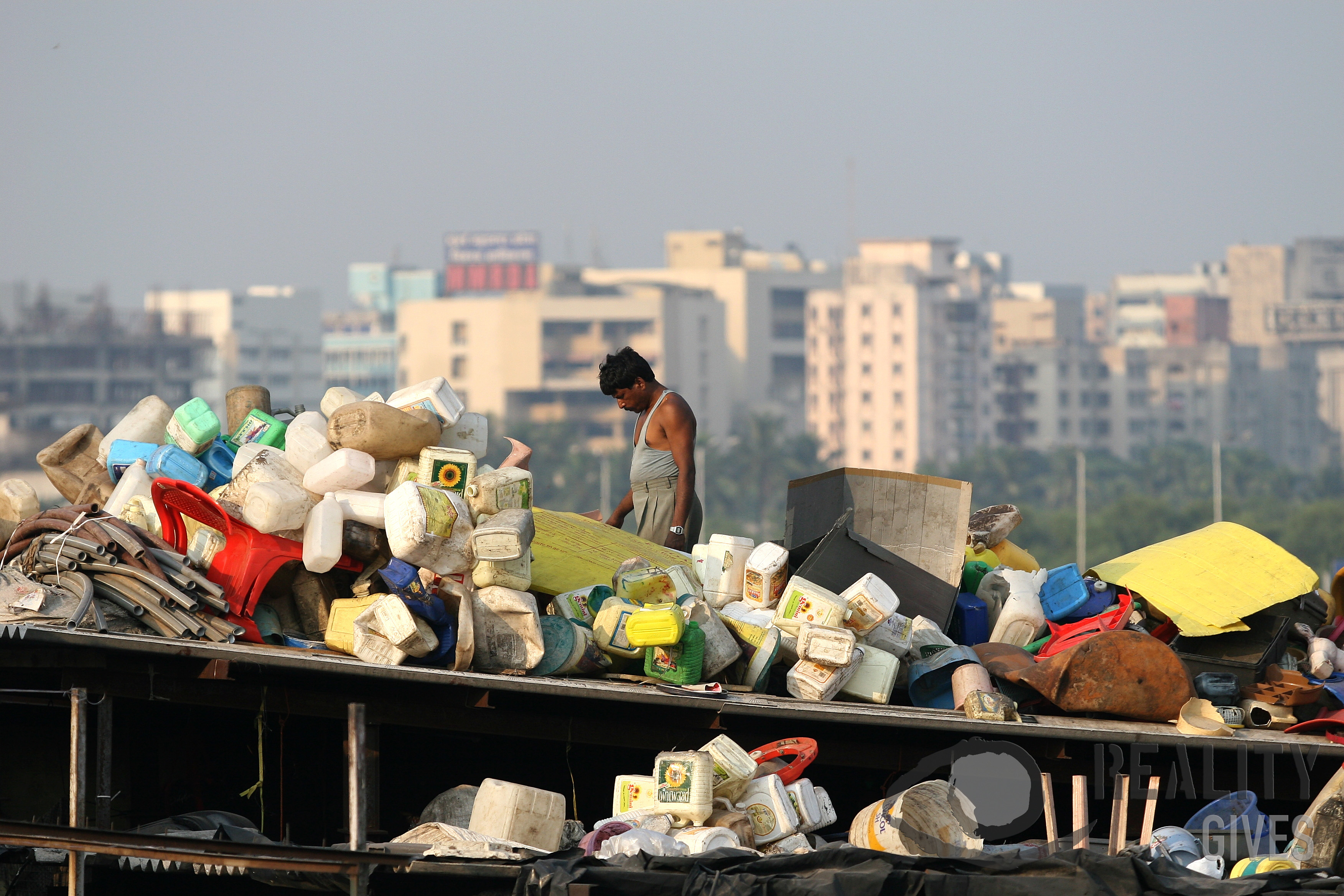
“Do you know why this is called a five-star slum?” our guide asked. Looking at my surroundings, her question surprised me. “Here in Dharavi,” she continued, “The community has many amenities: hospitals, public restrooms, schools, police, a firehouse, and twenty-four hours of electricity; why would one want to leave?” This past winter break was my fourth visit to Mumbai (Bombay), India. Mumbai is the capital city of the state of Maharashtra, and the financial, entertainment, and commercial capital of India. It is also the most populous and wealthiest city within India, but within the city, there is widespread poverty. While I had seen poverty in India before, this trip had a much larger impact. We took a tour of Dharavi, one of Asia’s largest slums.
The guide reminds us that the slums are a step up from living on the streets of Mumbai, and that the close-knit community of Dharavi is desirable. The people living in Dharavi have been there for generations and live on land owned by the government. With 1 million people living in an area half the size of Manhattan, New York City’s Central Park, there is extreme overcrowding, and conditions appear uninhabitable. We walked through the narrow, cramped alleyways, on rectangular cement tiles strategically placed on top of a water drainage route to create a walkway. The alleyways are half the distance of my arm span, and separate one family’s living area from another’s across the way. Entire families live in one-roomed homes smaller than my bedroom.
As we walked through Dharavi, children speaking beautiful English with smiles on their faces greeted us. They spoke Hindi to one another, but knew our guide was leading a tour group, and asked us in English, “Where are you from? What is your name?” Some children ran around chasing each other and laughing, and younger ones played upon heaps of garbage. The garbage dumps could be cleaned and made into a park for children, but our guide said if garbage was removed, the government would step in to construct buildings on the cleared land. Citizens of Dharavi do not want this, because it takes away the only open areas, and they cannot afford to live in the newly constructed government buildings. Thus, the only open areas remain as a garbage dump to prevent government-mandated development of the land.
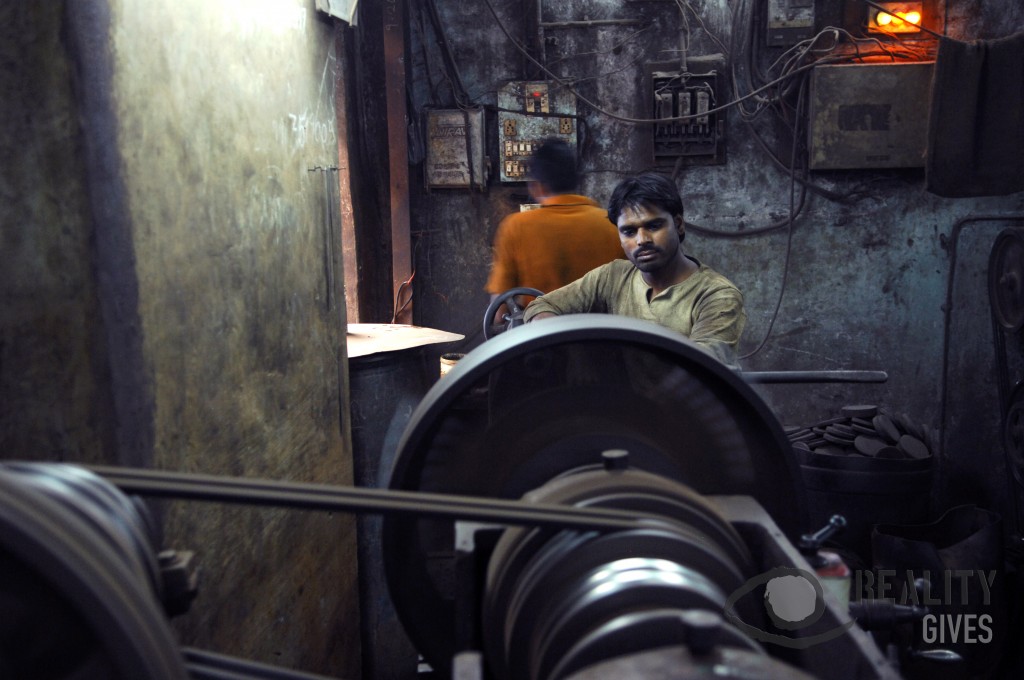
In the factory area of Dharavi, there are many types of jobs available. The garment area reveals giant embroidery machines, where one person can do the work of ten workers. The leather works area shows the process from animal hide to final product. The tour guide would not disclose the brands that were exported from this area, but one could imagine from the styles and embroidery of the garments, handbags, belts, and other leatherwear, that products from high profile companies originate in this location. The factory area even has a soap manufacturing area, in which large pans drying brown-colored soap that, at first glance, looked like a sheet of chocolate cake, are cut into soap bars and distributed to Laundromats within Mumbai. Different snacks, such as puff pastry tea biscuits, and papadi, a crisp flatbread sundried on woven baskets, are also made there, and are sold within India, and around the world.
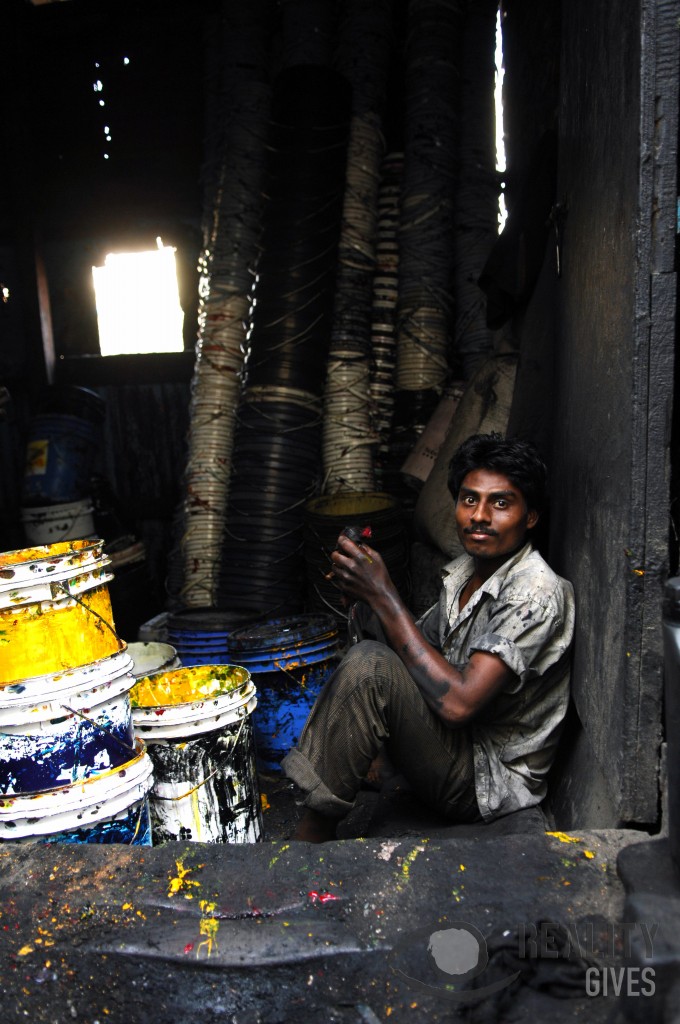
The types of jobs that workers have can be very specific, such as the process of paint tin recycling: one person’s job is to scrape the old paint off the inside of the cans and wash it, another scrapes the old paint label off the paint can, and another hammers it back into a cylindrical shape. There is also widespread recycling and trash collection. Women and children go out into the streets of Mumbai and collect recyclables and trash to bring back to the slum. Additional recyclables may arrive to the slum from other parts of the world that are unable to recycle them. After the trash and plastics are collected, they are sorted based upon color and quality, washed, and left to dry on rooftops. When our tour group climbed up a ladder stairwell to get to these rooftops, the flooring was worn, uneven, and not very stable. From the rooftops, one can see a view of the extensive area of the slums, and how concentrated and close together the establishments are. A recycling machine, which was invented in the slum at Dharavi, shreds plastic recyclables into small pellets that can then be melted and made into non-food grade recyclables. This plastics-processing machine has been exported to Australia and parts of Europe.
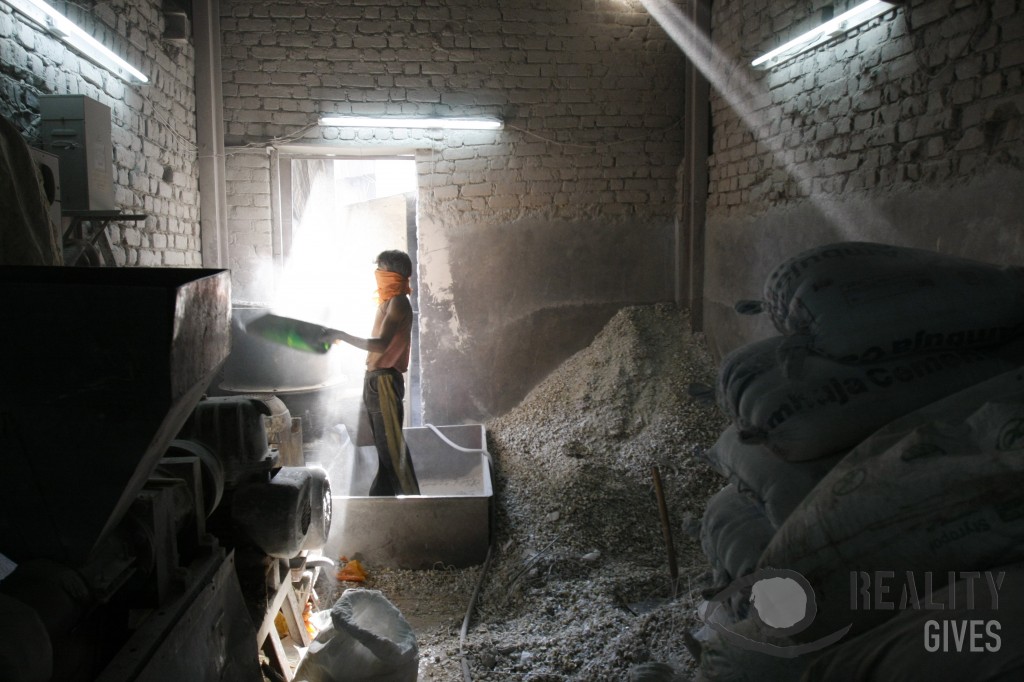
Some workers labor in toxic conditions without proper protection. A walk through these factories reveals workers operating sharp, heavy machinery without gloves or goggles, because the cramped conditions and extreme heat makes such protective gear unbearable to wear while working. There is no air conditioning, and while it was not the typical heavy rainfall or monsoon season in Mumbai when I visited, I cannot imagine how the heavy monsoons contribute to the hazardous conditions already present. More than likely, the areas within Dharavi would experience extreme flooding, since much of the area is not on high ground. At the aluminum factory, cans are melted into bars, and workers labor in a room with ventilation created by spaces between roof shingles, hardly safe from the aluminum toxins released openly into the air. The floors are often purely dirt, with dispersed nails, and sharp metal scraps scattered about. Walking through the factories required caution for those in our tour group, but often, workers work barefoot or with thin sandals that are hardly protective.
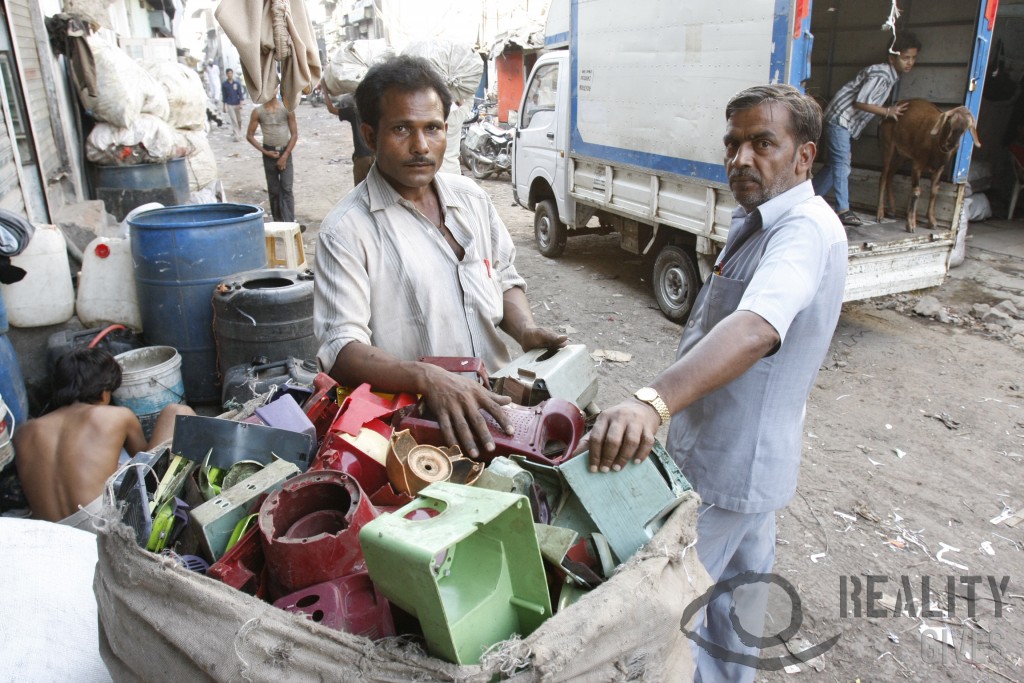
While some workers in the factories come from Mumbai, many others come from all other cities within India, just to find a job. They receive 150 rupees or $2.50 pay per month until they learn the proper skills and are paid progressively more, up to 6000 rupees or $100 per month. The minimum recommended amount of money for food per person per month (consuming a 2,000 calorie diet) in Mumbai averages $118 (Numbeo, 2014). Thus, workers in Dharavi do not even make enough money to cover basic food expenses for one person, and likely must spend less on food (thus, neglecting proper nutrition) in order to finance any other necessary expenses. The average monthly disposable income of a person working in Mumbai is $538, showing that there is a large income disparity among workers in Dharavi, compared to those in the greater city of Mumbai (Numbeo, 2014).
Mumbai is considered one of the most expensive cities in the world to live in, and housing costs are extremely high. The average price per square foot costs approximately $970 (Rapoza, 2013). The “houses,” which are generally single rooms housing an entire family, are less than 200 square feet, and typically, less than 100 square feet (Kumar, 2011; Singh, 2014). Thus, factory workers cannot afford the housing costs in the residential area of Dharavi, so they live in the factory itself. The owner receives free security when the shops are closed, and assurance that workers will be on time to work in the morning. Factory owners often live in the greater city of Mumbai, not in Dharavi, and in richer neighborhoods, showing worker exploitation. For example, one owner owns 12 different garment workshops and has 300 employees, generating about $2.5 million a year (Yardley, 2011). The irony of the extremely unequal pay of its workers is that Dharavi is a hub of economic activity, with an estimated annual output ranging from $600 million to more than $1 billion (Yardley, 2011). Many of the products manufactured are sold within India, and exported to various countries around the world.
There are environmental and health concerns within this slum. Garbage and waste from the residential and factory areas are dumped along the side river, which flows directly into the ocean, without filtration. Chances are that there are toxic chemicals released into the river, which could affect the environment of the fish and the health of those who consume the seafood. While there are government and private hospitals and clinics within Dharavi, one thousand people die of cholera and malaria each year. Extreme temperatures, unsanitary living and working conditions, and low income, would all be contributing factors in the progression of these diseases. As our guide explained, “God takes care of the elderly,” suggesting that many do not make it to their senior years.
On the other side of the world, I live, work, and study in the comforts of a clean and safe college environment, and I see that the inequality that exists in Dharavi begs solving. The problem that exists in this and other slums is multifaceted. The first problem that I saw was the extreme overcrowding and overdevelopment of the land. The different factory rooms were all adjacent to each other, with operating machines leaving little extra space to navigate through the factory safely. Narrow alleyways zigzagged like a maze through the residential area, with the one-roomed homes tightly packed close together. Often, residents build second floors upon the already overcrowded first-levels, to rent to those looking for a living space. In combination with the population density within Dharavi, and the overcrowded, narrow streets, there is a potential for compromised safety in terms of building accidents, or motor vehicle and pedestrian collisions, on the narrow streets.
A second major problem is the sanitation issue. While “public restrooms,” or, rather, in-ground latrines, exist, they are sparse, and often many must wait in lines for their use. Thus, open defecation and urination is common. This can lead to increase spread of infection among slum dwellers. The trash piles, coupled with extremely high temperatures can create an environment ridden with mosquitoes and diseases. The “roads” are often dirt, and while common on inner streets in India, the dust from the hot, dry climate, coupled with the pollution from factories, can contribute to asthma, allergies, and other upper respiratory illnesses.
An overarching problem, the elephant in the room, is of course, poverty. Poverty exists in this slum, like many areas of India. Without economic security, families do not have the means to afford safe living areas, and may have no choice but to work in the hazardous conditions and under harsh, unfair labor practices. Support for the poor is a problem that is seen worldwide, and individuals and families often must choose to focus on having a secure job, and a stable income to afford necessities, rather than the environment in which they are living in.
So, what can be done? Focusing on research in any of the aforementioned areas can be a good starting point. The first step would be to find a way to ensure the problem does not continue to grow larger than it already is. There needs to be a way to control and stop the inequality and hazardous health and living conditions that already exist in Dharavi, from spreading. By conducting studies which compile and explain the living and working conditions and environmental and health hazards that workers and citizens are exposed to, preventive measures can be suggested and implemented. The second step would be to improve working and living conditions for the people there. If a solution could be found to decrease overcrowding and overdevelopment, it would be possible to simultaneously decrease health and safety risks. Improving sanitation in the slum could better the health of citizens, and increase longevity. The third step would be to encourage improvements within Dharavi, and implement ways to lift people out of poverty. This could help families focus on their health and lifestyle, rather than worrying about day-to-day necessities. Improved wages for workers would be one way in which to begin this process.
Reality Tours, which organizes the tour of Dharavi, is taking small steps to make a positive impact in this slum by donating 80% of profits to its sister NGO organization, Reality Gives. This NGO provides education, youth empowerment programs, computer courses, art classes, health clinics, and environmental programs to those in Dharavi. These programs help provide relief for those faced with health problems, and can decrease the mortality rate caused by infectious disease. The education for young children provided through the NGO can also inspire them to aspire to obtain jobs and housing outside the slum, which could lead to a better life in the future. More support for these organizations will continue to help those living in Dharavi. With more research, attention, and support for areas like Dharavi, the condition of this slum and others like it, can change. It will take time, but small steps can be taken so that one day, Dharavi and slums like it, can truly become five-star, by American standards.
References
Kumar, R. (2011, November 15). In Mumbai, the $50,000 Slum Shack. The New York Times. Retrieved May 16, 2014, from http://india.blogs.nytimes.com/2011/11/15/in-mumbai-the-50000-slum-shack/?_php=true&_type=blogs&_r=0
Numbeo. (2014). Food Prices in Mumbai, India. Retrieved May 16, 2014, from http://www.numbeo.com/food- prices/city_result.jsp?country=India&city=Mumbai&displayCurrency=USD
Numbeo. (2014, May). Cost of Living in Mumbai, India. Numbeo Prices in Mumbai. Retrieved May 16, 2014, from http://www.numbeo.com/cost-of- living/city_result.jsp?country=India&city=Mumbai&displayCurrency=US
Rapoza, K. (2013, March 23). The World’s Most Expensive Cities. Forbes. Retrieved May 16, 2014, from http://www.forbes.com/sites/kenrapoza/2013/03/23/the-worlds-most-expensive-cities/
Reality Gives. (2014). Reality Gives. Retrieved May 16, 2014, from http://www.realitygives.org/
Reality Tours & Travel. (2014). Reality Tours & Travel – See the real India! Retrieved May 16, 2014, from http://www.realitytoursandtravel.com/
Singh, V. (2014, February 9). Dharavi slum-dwellers reject 300 sq ft MHADA flats, want bigger homes. Mid-Day News. Retrieved May 16, 2014, from http://www.mid- day.com/articles/dharavi-slum-dwellers-reject-300-sq-ft-mhada-flats-want-bigger- homes/15082061
Yardley, J. (2011, December 28). In One Slum, Misery, Work, Politics and Hope. The New York Times. Retrieved May 16, 2014, from http://www.nytimes.com/2011/12/29/world/asia/in- indian-slum-misery-work-politics-and-hope.html?pagewanted=all
Biography
 Jana Soares is a senior Honors Student, majoring in Biology and minoring in Chemistry, at St. Edward’s University. Originally from Suffern, New York, she moved with her family to Austin, Texas, shortly after beginning college. She enjoys documenting her travels via journaling. In addition to numerous trips to India, she has traveled to Canada, Portugal, and Spain, and lived with a host family in Japan one summer. This piece was written to explain to others what she witnessed on her most recent visit to India, an experience much different from previous trips. It also serves as a starting point in her research for her Honors Thesis: How Poverty Affects Health in the United States and India. Jana has conducted immunology and microbiology research, and plans to apply to a PhD program to continue researching disease prevention and health disparities.
Jana Soares is a senior Honors Student, majoring in Biology and minoring in Chemistry, at St. Edward’s University. Originally from Suffern, New York, she moved with her family to Austin, Texas, shortly after beginning college. She enjoys documenting her travels via journaling. In addition to numerous trips to India, she has traveled to Canada, Portugal, and Spain, and lived with a host family in Japan one summer. This piece was written to explain to others what she witnessed on her most recent visit to India, an experience much different from previous trips. It also serves as a starting point in her research for her Honors Thesis: How Poverty Affects Health in the United States and India. Jana has conducted immunology and microbiology research, and plans to apply to a PhD program to continue researching disease prevention and health disparities.
